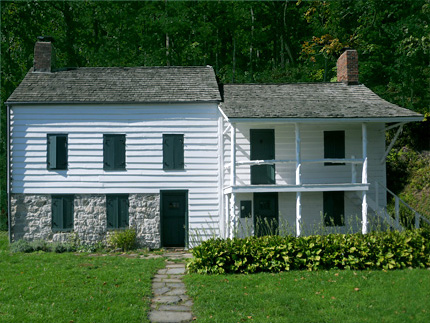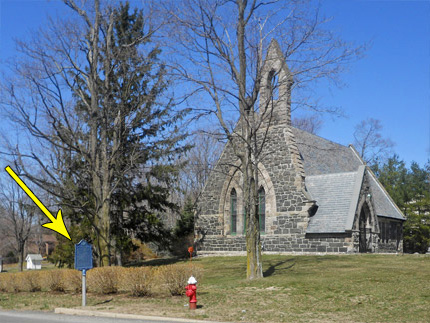


Huyler's Landing (Lower Closter Landing)
Located on the Hudson River,
within Palisades Interstate Park
GPS: 40.926808, -73.925718
Map / Directions to Huyler's Landing
Map / Directions to all Alpine Revolutionary War Sites
On the night of November 19-20, 1776, British and Hessian troops under the command of General Cornwallis crossed the Hudson River from New York City, causing the American troops to abandon their encampment at Fort Lee and begin a retreat across New Jersey. It is believed that they disembarked about six miles north of Fort Lee at Huyler's Landing, which was then called "Lower Closter Landing" or "the New Dock." From here they traveled inland up a road called Huyler's Landing Road, which no longer exists, and then turned south towards Fort Lee.
See the Fort Lee page of this website for a detailed description of the events surrounding Fort Lee and the invasion.

Huyler's Landing Hiking Trail
Palisades Interstate Park
• Access the trail from the Alpine Lookout parking lot
on Palisades Interstate Parkway North
Map / Directions to the Alpine Lookout parking lot
Map / Directions to all Alpine Revolutionary War Sites
From the Alpine Lookout parking lot, follow the Long Path (aqua blazes) south for 0.4 mile to the beginning of the Huyler's Landing Trail. The Huyler's Landing Trail is then a 0.6 mile hike down a 440- foot descent to Huyler's Landing
Maps of the park, including maps of the hiking trails, can be found on the New Jersey Palisades Interstate Park website.
The Huyler's Landing Trail runs from Huyler's Landing to the top of the Palisades. Hiking this trail gives you an idea of the difficulties that the British and Hessian troops would have faced to make it up the steep climb of the Palisades. The first group of troops climbed this ascent while it was still dark, and it was raining. A second group made the climb after sunrise when the rain had stopped, and so had the benefit of sunlight. However this group had task of moving the cannons up the steep hill.

The Kearney House (Previously known as Cornwallis' Headquarters)
Palisades Interstate Park
Near the Alpine Boat Basin /
Take Exit 2 off Palisades Interstate Parkway
Map / Directions to the Kearney House
Map / Directions to all Alpine Revolutionary War Sites
For information about tours and upcoming events at the Kearney House,
see the Kearney House webpage: www.njpalisades.org/kearney.html
The Kearney House is located within Palisades Interstate Park, close to the Hudson River. The oldest portion of this house (the section on the left in the photo) was built before the Revolutionary War, likely after 1761.
For many decades, it was believed that the November 20, 1776 landing of Cornwallis' troops occurred at this location, which was then known as Upper Closter Landing or the Closter Dock, and that General Cornwallis made this house his headquarters. However, over the years historians began to doubt this version of events. It is now generally believed that the landing occurred about a mile-and-a-half south of here at Lower Closter Landing (see Huyler's Landing entry above on this page), and therefore that this was not Cornwallis' Headquarters.
While it is now generally accepted that this was not the site of the landing, and that the house was not Cornwallis' Headquarters, it is impossible to rule out that some portion of the British forces landed at this spot, or that this house played some role. At the very least, the house was here at the time of those events, only about a mile-and-a-half from Lower Closter Landing.
The Kearney House takes its name from the family of James and Rachel Kearney who moved into it in 1817. In 1831 James died, and later Rachel ran a tavern here. The section of the house on the right in the photo was added circa the 1840's. [1]




Closter Dock Road
Marker is at Closter Dock Rd. and Old Dock Rd., in front of the Alpine Community Church
Map / Directions to Closter Dock Road
Map / Directions to all Alpine Revolutionary War Sites
Closter Dock Road was used by troops during the Revolutionary War. The historic marker in front of the Alpine Community Church explains the road's history. [2]
There are a number of roads in Bergen County which date to the Revolutionary War era and are marked with signs that explain their history. Entries for some of these other roads can be found on the Cresskill, Emerson, Franklin Lakes, Haworth, Mahwah, Maywood, and Oakland pages of this website. [3]

1. ^ Information for this entry was drawn from several sources, including:
• John Spring, "The Invasion and the Myths Surrounding It," in Carol Karels, ed., The Revolutionary War in Bergen County - The Times That Tried Men's Souls (Charleston: The History Press, 2007) Pages 25 - 31
• “On His Lordship’s Mysterious Ascent” “Cliff Notes” (the park visitor letter for the Palisades Interstate Park in New Jersey) Nov. 1998 - available to be read on the Palisades Interstate Park in New Jersey website here
• The Kearney House brochure - available as a PDF on the Palisades Interstate Park in New Jersey website here
• Bergen County Stone House Survey - Individual Structure Survey Form for the Blackledge-Kearney House
Available as a PDF on the National Park Service /National Register of Historic Places website here.2. ^ Bergen County Historical Society sign
3. ^ See the pages linked in the text for more information about the other roads.
▸ For more information about this topic, see:
Benjamin Rubin, "The Revolutionary Roadways of Bergen County," in Barbara Z. Marchant, ed., Revolutionary Bergen County - The Road to Independence (Charleston, SC: The History Press, 2009), 151 - 161